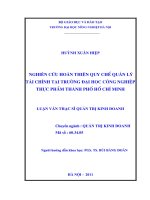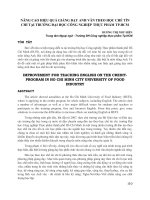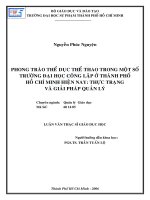GaN and Penta-Graphene nanoribbon - Trường Đại học Công nghiệp Thực phẩm Tp. Hồ Chí Minh
Bạn đang xem bản rút gọn của tài liệu. Xem và tải ngay bản đầy đủ của tài liệu tại đây (946.22 KB, 10 trang )
<span class='text_page_counter'>(1)</span><div class='page_container' data-page=1>
<b>MINISTRY OF EDUCATION </b>
<b>AND TRAINING </b>
<b>VIETNAM ACADEMY OF </b>
<b>SCIENCE AND TECHNOLOGY</b>
<b>GRADUATE UNIVERSITY SCIENCE AND TECHNOLOGY</b>
<b>……..….***………… </b>
PHAM THI BICH THAO
<b>ELECTRONIC TRANSPORT </b>
<b>IN SEMICONDUCTOR NANOSTRUCTURE </b>
<b>BASED ON POLAR MATERIAL AlGaN/GaN </b>
<b>AND PENTA-GRAPHENE NANORIBBON </b>
Speciality: Theoretical and mathematical physics
Code: 9 44 01 03
<b>SUMMARY OF THE PHD THESIS </b>
</div>
<span class='text_page_counter'>(2)</span><div class='page_container' data-page=2>
<b>Supervisors</b>
:
Assoc. Prof. Dr
. Nguyen Thanh Tien
Prof. Dr. Doan Nhat Quang
<b>Referee 1:</b>
Assoc. Prof. Dr
. Dinh Van Trung
<b>Referee 2:</b>
Prof. Dr
. Dao Tien Khoa
<b>Referee 3:</b>
Dr
. Pham Ngoc Dong
This dissertation will be defended in front of the evaluating assembly at
academy level, place of defending: meeting room, Graduate University
of Science and Technology, Vietnam Academy of Science and
Technology.
<b>This thesis can be studied at: </b>
</div>
<span class='text_page_counter'>(3)</span><div class='page_container' data-page=3>
1
Introduction
Nowadays, semiconductor technology is one of the most important fields
in the development of science and technology. Semiconductor technology is
a foundation of the information society that has been motivating human
so-ciety forward by changing in production, living, communication and even in
human. In semiconductor technology, semiconductor materials play a
cru-cial role. The first transistor was invented in 1947 based on germanium (Ge)
semiconductor with a band gap at room temperature of 0.66 eV. The first
integrated circuit was born in 1958 and the bulk integrated circuit appeared
in 1961 using germanium and silicon (Si) with a band gap of 1.12 eV. Since
1965, silicon has become the main material for semiconductor integrated
circuits. Today, most semiconductor, integrated circuit or photovoltaic
in-dustries are still based on silicon.
Silicon and germanium are often referred as the first generation of
semi-conductors. The second generation including gallium arsenide (GaAs, band
gap at room temperature is 1.42 eV) and indium phosphide (InP, band gap
at room temperature 1.35 eV) was introduced in the 1970s. The second
gen-eration is primarily used in high-speed devices, microwave devices and
inte-grated circuits. Besides the larger band gap, the electron mobility of GaAs
is more than six times larger than that of silicon. In addition, the saturation
velocity of GaAs is higher, i.e. two times larger than that of silicon.
There-fore, devices based on GaAs are suitable for high-frequency operations. In
addition, field-effect transistors based on GaAs also have advantages such
as low noise, high performance, ect. However, GaAs has lower thermal
con-ductivity and disruptive potential than semiconductors like GaN and SiC
have, resulting in capacity limitations.
</div>
<span class='text_page_counter'>(4)</span><div class='page_container' data-page=4>
Currently, semiconductor heterostructure is widely used in many fields
due to its great advantages. Specifically, in the telecommunication field
with semiconductor transistors, satellite television, warning systems, ect;
Energy field with solar cell, light-emitting diode, information storage device,
ect; Medical field with water filtration system, data processing system, ect.
Many studies show that the electric and optical properties of heterostructure
semiconductor vary significantly compared to those of the bulk
semiconduc-tor and by the external field. Moreover, the heterostructure semiconducsemiconduc-tor
also has superior intrinsic properties. One of the properties is that the
po-larization depends on the direction of the material and the structure of
the material, especially the low-dimensional structures. Therefore, the
het-erostructure semiconductor has been an attractive topic in modern material
research in recent decades.
Strong polarization effect exists in many materials such as GaN, ZnO,
MgO, InN, ect. Although there have been a number of studies on the
ef-fects of polarization on the electric properties of these structures, these
constructions have not been fully and systematically studied. In particular,
the heterostructure semiconductor with polarizing confinement effect needs
to be studied extensively. In addition, the relationship between confinement
effects and electronic transport characteristics should be studied in more
detail.
Along with the heterostructures, the allotropes of carbon are currently
at-tracting much attention. Until the mid-twentieth century, the two most
com-mon allotropes of carbon in nature were diacom-monds and graphite. Graphite
is a material consisting of two layers of carbon (2D) atoms arranged in a
hexagonal lattice. Because only 2 of the 3 orbitals p make bonds, there
is a unpaired orbit, pz, which can be used in electron transport.
There-fore, graphite is a good conductor. The next carbon allotrope, Buckminster
Fullerenes, was discovered in 1984 by Richard Smalley et. al. Next, the
single-walled carbon nanotubes were discovered by Iijima in 1990.
Intensive study of graphene, a two-dimensional (2D) material
consist-ing of carbon atoms in the hexagonal network, began in 2004. The most
notable characteristic of graphene is the thinnest crystal with extremely
hardness, outstanding elasticity and thermal conductivity. With a
two-dimensional structure and a large surface area of about 2675 m2/g, graphene
</div>
<span class='text_page_counter'>(5)</span><div class='page_container' data-page=5>
vari-3
ous chemical reactions and interactions. This creates great prospects for
changing the properties of graphene. Over the years, many theoretical and
empirical studies for graphene have been carried out. Specifically, the
syn-thesis of single-layer, multi-layer graphene or graphene nanoribbon on the
metal substrate were performed. The electronic, chemical, magnetic and
electrochemical properties of graphene have also been considered.
Although graphene has excellent physical and chemical properties, graphene
is a gapless material, which makes it difficult to apply graphene in field effect
transistors and other electronic devices.
In 2015, a new allotrope of carbon, penta-graphene is predicted by Zhang
et. al. Penta-graphene (PG) exhibits mechanical and kinetic stability even
when the temperature reaches 1000 K. In addition, penta-graphene has a
direct band gap about 3.25 eV, which is higher than that of other allotropes
of carbon. Penta-graphene exhibits many unique electric, thermal and
opti-cal properties. Studies on penta-graphene also show that hydrogenation can
increase the thermal conductivity of PG. PG doping Si, B, N Ge and Sn can
reduce the band gap of PG, while doping transition metal can increase or
decrease the band gap and simultaneously greatly enhances the absorption
of hydrogen. With a large surface area ratio and band gap, PG is beneficial
for adsorption of gas molecules. Recently, due to the superior physical and
chemical properties, PG has been studied through theoretical calculations
and showed that they have great potential for application in the field of
nanoelectronics, nano mechanics and catalysts.
From penta-graphene, one can form four types of penta-graphene
nanorib-bon (PGNR) with different boundary forms. Investigation of the electronic
properties of four types of PGNRs shows that structures exhibit
semicon-ductor or metal properties. A number of works have focused on the
elec-tronic properties of pure PGNR structures, passivation by different atoms
or magnetic properties of PGNR forms.
From the above analysis, the effect of polarization on electronic
trans-port in low-dimensional systems, in particular 2D systems, need to be
stud-ied in detail. In addition, the electronic transport of novel material like
graphene, namely penta-graphene nanoribbon, should be investigated more
fully. Therefore, problems such as polar heterostructure, electronic
proper-ties in low-dimensional systems have to consider the influence of polarized
charge, structural properties and electronic transport properties in
penta-graphene nanoribbon will be presented in this thesis.
The purposes of research
Studying on electronic transport phenomena in semiconductor nano
struc-tures such as AlGaN/GaN and penta-graphene nanoribbon.
The objects of research
</div>
<span class='text_page_counter'>(6)</span><div class='page_container' data-page=6>
GaN/GaN and penta-graphene nanoribbon.
The methods of research
- Using the variational method to determine the electronic properties
and deriving analytical expressions related to the mobility specific to the
electronic transport phenomenon in the AlGaN/GaN system.
- Using numerical methods, programming by Mathematica to identify the
variational parameters and illustrate the physical quantities graphically.
- Using the density functional theory and the non-equilibrium Green's
function to investigate electronic characteristics (band structure, density
of state, ...) and electronic transport properties (I(V), T(E), ...) in
penta-graphene nanoribbon material system.
- Using Origin software to process data.
- Comparing with several experimental results.
The structure of thesis
The thesis is presented as follows:
Introduction: An overview of the thesis.
Content
Chapter 1: Overview of research materials.
Chapter 2: Electronic distribution in AlGaN / GaN structure.
Chapter 3: Electronic transport phenomenon in AlGaN / GaN structure.
Chapter 4: Phenomenon of electronic transport in doped penta - graphene
nanoribbon.
Conclusion: Summarizing the contributions of the thesis and stating prospects
for further research.
</div>
<span class='text_page_counter'>(7)</span><div class='page_container' data-page=7>
5
Chapter 1
Overview of research materials
1.1 Heterostructure AlGaN/GaN
1.1.1 Heterostructure
When the lattice mismatch between between the substrate and the layers
or between the layer and the layer is suitable, an ideal crystal was made
by two different material. These structures are called heterostructures. The
discontinuity of the material arising in the heterojunction leads to a change
in some important electrical and optical properties, such as carrier
confine-ment (due to the discontinuity of the conduction band or the valence band)
or radiation confinement (due to band gab discontinuity). The
heterostruc-ture is made from a thin semiconductor layer (about 100 nm), sandwiched
between two other semiconductor layers creating a potential well in the
con-duction or valence band and is often referred to as a quantum well. (QW)
(eg AlGaAs/GaAs/AlGaAs). Heterostructures are largely based on
semi-conductor alloys. Semisemi-conductor alloys can consist of two elements, three
elements or four elements (for example, GaAs, InAs, InP, GaAs, GaP,
Al-GaAs, InGaAsP, ...).
1.1.2 Polar heterostructure
Polarization is an important characteristic of group III nitride
semicon-ductors. Wurtzite group III nitride structures do not have inversion
symme-try along thecaxis. The strong ionicity of the metal - nitrogen bond results
</div>
<span class='text_page_counter'>(8)</span><div class='page_container' data-page=8>
Figure 1.1: Atomic arrangement on Ga and N surface of GaN crystal.
Arrows indicate spontaneous polarization.
The additional polarization in group III nitride structures due to strain
is called piezoelectric polarizationPz. The calculations for interface bound
charge and two-dimensional electronic gas (2DEG) depend on both
piezo-electric polarizationPzand spontaneous polarityPsp. The value ofPspin a
material is constant, whilePz is a function of strain and can be determined
from the following expression:
Pz= 2
a−a0
a0
e31−e33
C13
C33
(1.1)
witha0 is the lattice constant when the system in not affected by stress or
compression,ais the lattice constant when the system is affected by stress
or compression, e31 and e33 as piezoelectric coefficients. C13 and C33 as
elastic constants.
1.1.3 The effect of polarized charge on electronic
trans-port in AlGaN/GaN polar heterojunction
In AlGaN/GaN polar heterostructure, 2DEG density is very high, can
reach n2d ≈ 2×1013 cm−2 and moblity at room temperature µ ≈ 1500
cm2<sub>/</sub><sub>V.s. The 2DEG sheet carrier density can be modulated by varying the</sub>
AlGaN barrier thickness as well as the Al content. When a strong
polariza-tion occurs (∼ 1 MVcm−1<sub>), the electrons are electrostaticly repelled close</sub>
</div>
<span class='text_page_counter'>(9)</span><div class='page_container' data-page=9>
7
and surface roughness scattering. These scattering processes predominate
at low temperatures, and even at room temperature when 2DEG is high
density.
In polar heterostructures, a new scattering mechanism does not exist in
non-polar semiconductors and weak polarized semiconductors called dipole
scattering. This is due to the alloy disorder, resulting in the dipole moments
in each unit cell being non-periodic with the lattice.
The charge distribution in the direction of[0001]of the polar
heterostruc-turs can be determined by solving the Schrodinger equation and the Poisson
equation in the approximate effective mass.
1.2
Graphene and penta-graphene
1.2.1 Graphene
Graphene is a single graphite layer with high carrier mobility, in the
range of 20005000 cm2<sub>/Vs. Therefore, graphene is applicable to field-effect</sub>
transistors (FET) operating at high frequencies. Graphene also exhibits high
optical transparency of up to 97.7%which should be a potential candidate
for solar cell, storing three-dimensional data. In addition, graphene also has
high thermal conductivity, high Young's modulus and large surface area.
However, graphene is a gapless structure, so it is limited for applications
in the field of optoelectronics. As a result, different methods have been
implemented to open the band gap of graphene such as doping, changing
edge, applied field, ...
1.2.2 Graphene nanoribbon
Graphene nanoribbon (GNR) is a one-dimensional structure formed by
cutting graphene in different crystal directions. Based on the edge of graphene
nanoribbon, there are two types of graphene nanoribbon: zigzag graphene
nanoribbons (ZGNR) and armchair graphene nanoribbons (AGNR). In
gen-eral, the properties of GNR are sensitive to many factors, such as doping,
defects, edge changes, adsorption and external electric fields. This offers
many opportunities to tune and expand GNR applications. Among the
pro-posed methods, doping is one of the most frequently ways to adjust the
properties of GNR.
1.2.3 Penta-graphene
</div>
<span class='text_page_counter'>(10)</span><div class='page_container' data-page=10>
dis-and the bond angles of penta-graphene structure is also affected by doping,
passivation, ...
Figure 1.2: Penta-graphene nanoribbons.
1.2.4 Penta-graphene nanoribbon
So far, 4 types of penta-graphene nanoribbon (PGNR) have been created:
zigzag PGNR (ZZPGNR), armchair PGNR (AAPGNR), zigzag-armchair
PGNR (ZAPGNR) and sawtooth PGNR (SSPGNR) (Figure 1.2).
</div>
<!--links-->









